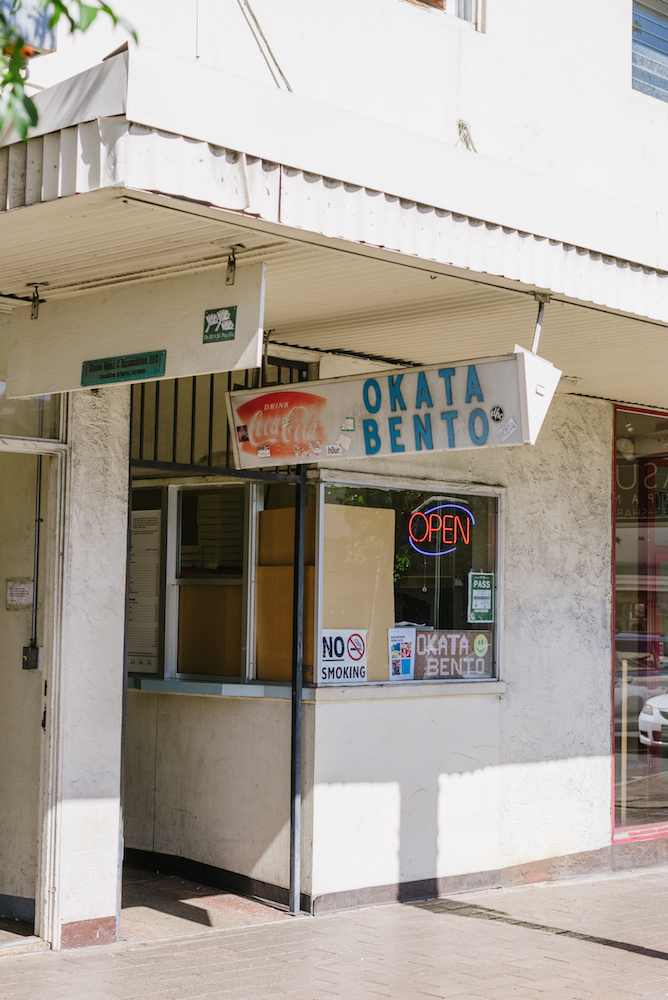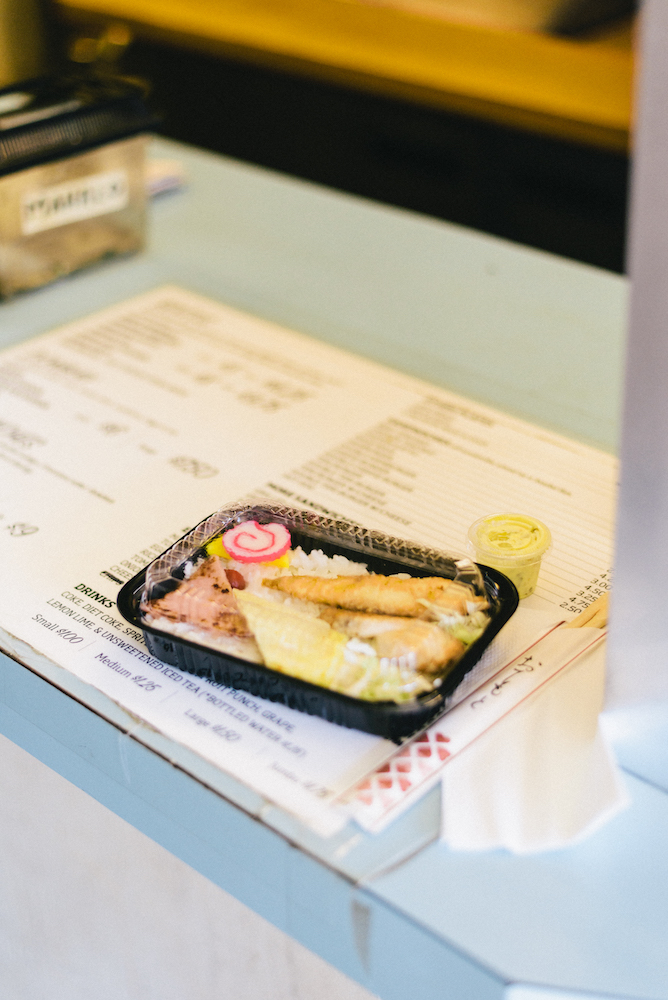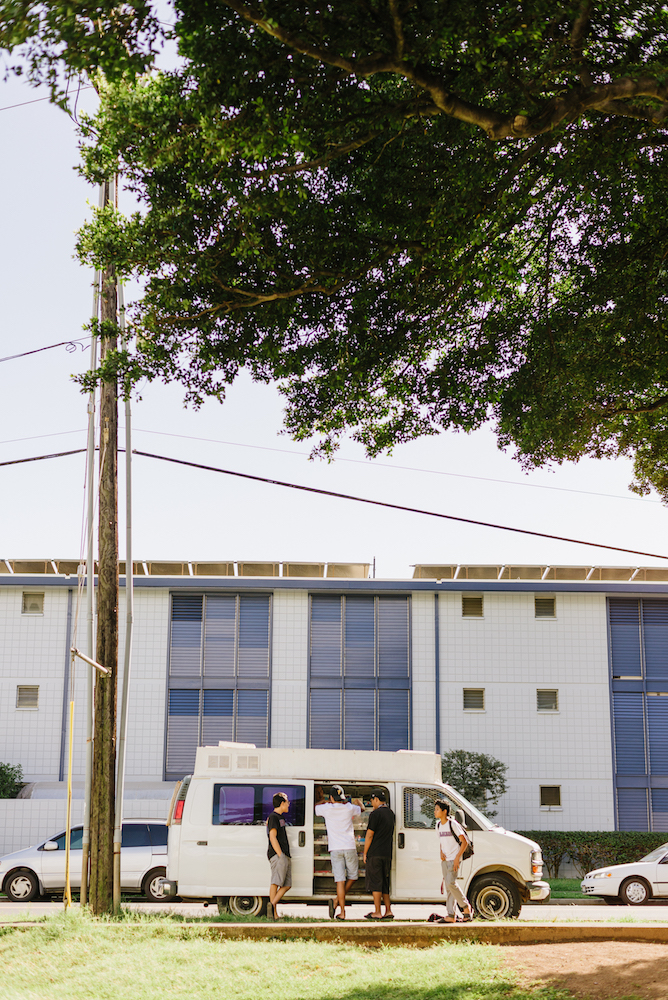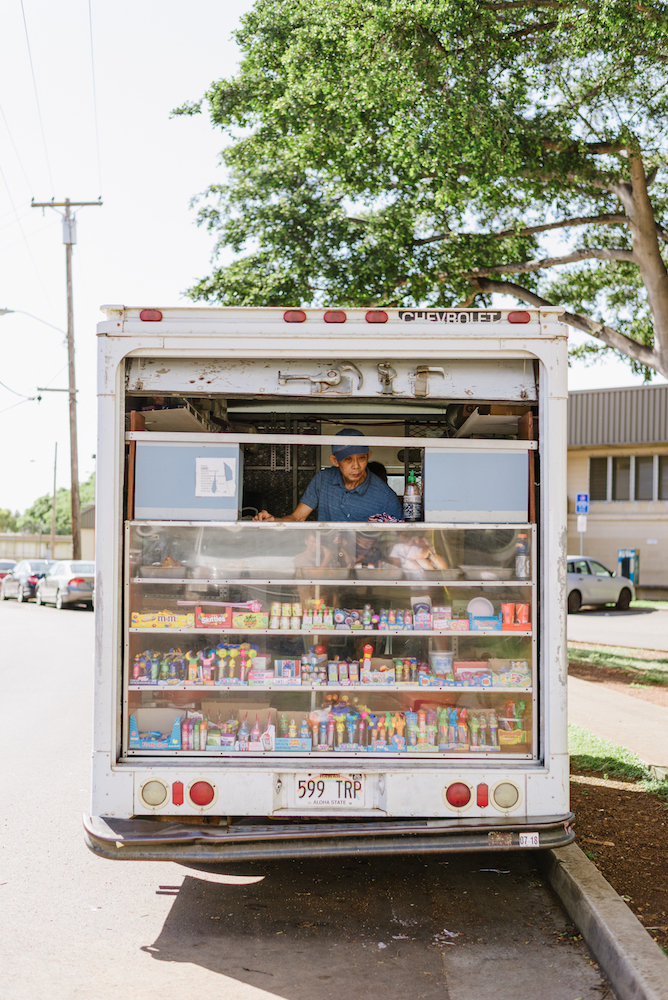Images by AJ Feducia
Three keepers of the flame and where to still find them, for now.
Maybe you have to leave to truly long for the taste. Maybe, like the literal li hing mui (“traveling plum” in Cantonese), you must experience your own personal odyssey to appreciate the foods of your youth. Because if anything evokes the complex flavors of a childhood in Hawai‘i, it’s the delicacies sold at the neighborhood crack seed shops, the pork hash behind the foggy plexiglass in the manapua man’s van, the aromas wafting from the bento and okazuya takeout windows.
Maybe no other such flavors capture the essence of growing up here like those of see mui or manapua, from the sweet (your first kiss), to the salty (a day at the beach park), to the sour (the lump in your throat as the aircraft pierces through the clouds and you watch your home slowly fade away).
Maybe the entire human experience is found within a preserved plum. Maybe li hing mui powder is pixie dust to find your way home. Second star to the right, straight on till Diamond Head…


Crack Seed
The interior of the very literally named Crack Seed Store on Koko Head Avenue near Waiʻalae Avenue resembles a fabled medieval apothecary more than a modern small business. Multiple tiers of large glass jars showcasing the goods crowd the small shop, sharing space with an Icee machine, a beef jerky case, shelves of Tomoe Ame rice candies, boxes of Yan Yan dip sticks, and two scales—one analog, the other digital.
But instead of potions like witch hazel or laudanum, within the jars sit see mui, lemon peel, and other precious preserves labeled “Soft and Sweet,” “Red Seedless,” “White Seedless,” “Dry Rock Salt,” “Sweet and Sour Cherry,” “Wet Mui,” “King Mui,” “Baby Mui,” “Honey Ume.”
The ever-jovial K.P. Young still mans his shop alone, as he has for 37 years. He bought the business in 1979 from a woman who opened her own crack seed operation there in the late 1950s.
A wide range of local people from varying generations funnel in and out, with little break for Young. I watch as a customer asks for a quarter pound of rock salt plum, and Young shovels the seeds with one deft scoop, weighing the amount right on the money, like a magician.


It’s kind of sad, because there’s definitely less crack seed stores these days, since the children aren’t taking over.
Has he done much modernizing since 1979? Sure. Young has gone from twist ties to a sealing machine for the plastic baggies. And while it might look like he makes his own product, he tells me that he has been importing all the crack seed from Hong Kong, Taiwan, and now Thailand. The company that seasons the see mui has a family secret formula, he says, passed on through the ages.
I ask him if his own children will likely take over his business when he’s too old, and he smiles and shakes his head.
“My kids all have their own jobs,” he says. “Crack seed is a hard business. It’s not easy. First of all, it is a foreign product with a lot of regulations, and has to go through customs. Sometimes, when a shipment doesn’t come in, you even have to check on the foreign side. It’s kind of sad, because there’s definitely less crack seed stores these days, since the children aren’t taking over.”
Regardless of the decline of crack seed brick and mortars, I realize why Young’s smile won’t leave. Because on a gloomy Tuesday at 11 a.m., there’s still a line snaking out the door.
Okata Bento
Just around the corner from Crack Seed Store, on Waiʻalae Avenue, is Okata Bento, a comfort-food cornerstone with only a takeout window that has been in Kaimukī since 1981. I walk up to the literal hole in the wall and order a teriyaki beef and char siu chicken bento, while wondering if the prices are typos because it’s so affordable. It’s not a mistake. Score.
As I wait, trade workers in long-sleeve neon yellow shirts, bank tellers, and businesspeople swing by and grab their boxes with ease. Clearly I have not called in my order. Rookie mistake.
Lyndon Okata, Okata Bento’s owner and chef, has been running the show since he started the business as a food truck. He has counter help and an assistant, but Okata still does the work of three men behind the glass, making every bento, plate lunch, donburi, and sandwich upon order—hence the benefit of calling in.
I ask Okata what the most popular bento is, and he laughs.
“It’s so funny, because everybody has their favorite, so there’s not really one in particular,” he says. “Whenever a customer comes, I already know what they want. They basically order the exact same thing every single time. They rarely ever change their order. Even my kids growing up who would help me, we’d have this thing like, ‘Oh, the chicken katsu guy or chicken teri guy.’ You could automatically equate the order with the name.”
I ask Okata if he plans to pass the business on to his two children, but he doesn’t see that happening. They helped him growing up—at the counter, washing dishes, cleaning, prepping—but both now live in New York City. One is a fashion stylist and consultant, the other, a graphic designer.
While he’s got some items that other bento shops don’t always carry, like tonkatsu and a special char siu sauce that is the secret recipe of a friend, Okata believes the reason for the joint’s ongoing popularity is consistency.
“It’s only me cooking, me preparing—it tastes the same every time,” Okata says. “Some places you go and they’ll have different cooks or maybe different staff, so taste can change. But not here, I feel.”
At this moment, a hurried businessman in an aloha shirt swings by for his order. I’m new at this, but I have a strange inkling it’s the chicken katsu guy.
Manapua Truck
If you are not from a neighborhood with a manapua man, it can be difficult to locate one. Manapua men and manapua women don’t do websites. They don’t take card. They don’t strive for sparkling Yelp reviews.
To find one of their aging vehicles—normally a white converted van—you must rely on word of mouth. That, or trending hashtags with GPS coordinates.
Making use of my full bars on the coconut wireless, I hear of a van that parks across from the Kalakaua Boxing Gym at District Park on McNeill Street in Kalihi Kai.
I go there, find a spot on the bend in the road by the basketball courts, and while I fiddle with my windshield sun shade, I notice two separate drug deals go down in a span of 30 seconds. I approach a van with middle schoolers and park goers huddled around its side window, and get a couple curious looks like, “You ain’t from around these parts are ya, boy?”
Manapua men and manapua women don’t do websites. They don’t take card. They don’t strive for sparkling Yelp reviews.
Manapua is a savory local version of the Chinese pastry char siu bao. But I’ve always wanted to get to the bottom of the food’s Hawaiian etymology: Is it from mea ʻono puaʻa, meaning, “delicious pork,” or mauna puaʻa, meaning “mountain of pork?” There is a fierce debate over this, but I keep my nerdy questions to myself, and study the menu.
Manapua, rice cake, pork hash, fried pork hash, fried noodles, SPAM musubi, and other local hits, most for under $2. Also available, a collection of soft drinks, Hawaiian Suns, and enough candy to trigger type 2 diabetes.
I’m going with a “mountain of pork” because it’s leg day, plus a musubi because I’m starving. I squirt some shoyu from the Sriracha bottle I snagged from the counter over the musubi rice because I love myself.
Fathers with toddlers on their shoulders cross the street from their apartments and get in line. A tūtū and her grandson make their way from the elementary school.
A kid pushes over from the courts on a skateboard. I realize that my carbon footprint was a few sizes larger than everyone’s here. If you gotta drive to a manapua man, you’re not from the neighborhood.
There are flavors that bring us back to places that still exist—though there may not be any successors. They transport us back to hanabada dayz. Their aromas emanate from holes in walls and counters in vans that were established well before the food truck craze.
These flavors transcend health codes and seating and advertisement. They are safe havens and crafts, and spaces that smell and sound and taste, like home.





